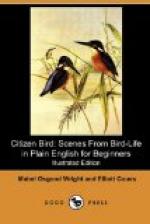“Almost all Wild Ducks nest in the northern tier of States, or altogether north of them; the hardier species stay with us as winter visitors, but the others only stop to feed, as they follow the rivers and coasts in their migrations.
“There was a beautiful Duck that had a nest last year in a tree up near the logging camp; its feathers were as bright as if they had been painted. That is the Wood Duck—one of the exceptions to the rule that Wild Ducks nest on the ground like tame ones. Another kind, the Black Duck, nests as usual on the ground, on a wooded island not far from the one to which we are sailing.”
“Will you please tell us why Ducks have such waddling legs?” begged Nat.
“Because the best legs to swim with are not the easiest to walk with.”
At that moment the wind died down. The sails flapped once or twice, and then hung loose; and the boat, instead of dashing along, began to drift lazily, with an uncomfortable rolling motion, as the swell, borne in from the ocean many miles away, crept under it.
“If the water does that much more, I shall soon be hungry,” said Dodo, looking a trifle sad and pressing her hands together over her waist.
“I quite agree with you,” said Olive; “I know from having had the same feeling before, that unless we eat some of these little salt biscuits, and talk about something interesting, in a very few minutes you and I will be sea-sick—which is the hungriest, emptiest sickness possible.”
“I thought the feeling was a little more puffy than real hungriness,” said Dodo, chewing her biscuit in great haste and having some trouble in swallowing it.
“May not we men have some too?” asked the Doctor, looking drolly at the boys, who were glancing longingly at the biscuits, but were too proud to confess their feelings. “Not that we feel ill—oh, no! Merely for company, you know.
“Now while you munch away, I will talk Duck to amuse you; eating and Duck talk go very well together, for the Duck is chiefly to be considered as food. You all know what a well-rounded, compact body a Duck has; do you remember having seen one carved, and how very hard it was to cut off its legs?”
“Yes, I do,” said Nat. “Sometimes the Duck almost bounces off the dish, and then, father says things—at least, I mean, he says he wishes that people who go shooting and send him presents of Wild Ducks would send a carving map and a good sharp knife with them; but I never understood what he wanted the map for.”
“To find the joints, my boy,” laughed the Doctor, as if he had a sympathetic feeling for carvers who find themselves in front of a tough Duck or Goose, no matter how well they know where the joints ought to be found. “A Duck’s legs are very short, and not only set far back on the body, but sunk into the skin quite up to the knees; so that the joints are very hard to find. This is planned to give the Duck more strength and ease in swimming, when the legs act like paddles. All Ducks’ feet have three long toes in front and a short one behind, the front toes being loosely joined by two skin flaps which stretch between them when spread apart, making what we call web-feet.”




